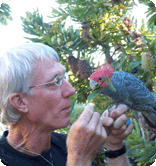Repeat infection in a Goffins Cockatoo

I address this query to E.B. Cravens, a person whose expertise I greatly respect from reading his articles in the Redwood Empire Cage Bird Club newsletter.
My goffins cockatoo (20 yrs old) has been having an on/off ‘infection’ in his wing pit the last couple of years. Originally I was told it was a fungal infection, then a staph infection. He was given antibiotics (3 times in 1.5 yrs) mixed in his water. Each time it cleared up. Last AB treatment ceased 2 mos. ago, then I noticed yesterday that it has started up again in his left wing pit. It occurs mostly in his right wing pit, but his left side is occasionally affected - to a lesser degree. It looks a bit oozy, and crusts up. We were told it is because he picks at it; however, my thought is that he picks BECAUSE he has and infection/fungus - which then worsens the issue. I fear he will become AB resistant; also, I do not want his immunity compromised.
I live in Sonoma County, CA. He is outdoors much of the time, playing in the various fruit trees and local natives. Fred also has an ongoing zinc issue (last 18 years) and wears a collar most of the time; I only take it off for a few min-hrs to let him preen.
I thought Staph was bacterial, not fungal. Would greatly appreciate your input.
Kindly, Roxanne

Dear Roxanne, Thank you for the kind words. I do not know if I am the right person to fully answer your question, since it is basically a medical issue; and I hope the WPT representatives will also ask Dr. Speer or his staff to add their comments…
That said, here is my two cents worth, given from a rural resident who does not have available bird medical service on hand:
Are you working with a certified avian veterinarian? Has he or she identified the microorganism through cultures? Being told it is a different thing once or twice can certainly be frustrating and it needs to be tied down more specifically. Sometimes a bacteria like staphylococcus can also weaken a parrot so that fungus can invade. There are many species of staph, some which are known to reside on bird hosts, some which are very difficult to eradicate when established. Once your culprit is identified, sensitivity tests will determine a medicine that can attack it.
Personally, with an exterior infection, I would also like to treat the sores topically. As such, we prefer to use holistic applications that can work concurrently with your antibiotics. If your cockatoo has healed and been without lesions on a prior treatment, that would indicate that the bird has certain capabilities to beat the infection with medical help. But should he be in an environment where the staph is heavily prevalent (ie…some soils, weathered woodstuffs, mildewed ropes, etc) it might be that he is continually exposed to more of the same.
This is what I would recommend:
1) Don’t put her back on general antibiotics until you have a microbe identified and a medicine isolated that will kill it. Giver her multi-level avian probiotic powder now…..one of the good ones.
2) Begin to assess any items or cage furniture or the like that could harbor an infection and totally clean and sterilize them—it is not necessary to use strong disinfectants or bleach, just a good soap and water cleaning and sunlight drying will probably help. Throw away anything suspect. Think of it as spring cleaning down to the core.
3) Consider getting some citrus bioflavinoid—that is grapefruit seed extract, GSE, and using it in her water for three weeks and topically as a wash. Hospitals have reported some success with GSE in fighting staph infections. Bathe her regularly and I would use GSE in the water if a spray bottle works. We mix all ours at 9cc per gallon.
4) Get a soothing aloe vera gel or even better the raw plant sliced up and use that as a nighttime salve. Not only is it anti-bacterial and bitter to the taste of feather pickers, but is seals sore wounds under a mild film that speeds wound healing manyfold.
5) Put the parrot on a supplement with spirulina, trace minerals, and clay sprinkled on any wet food that she will eat.
6) If she is not getting any health food grit—-start to sprinkle it on her food…..cuttlebone hard shell bits scraped off, oyster shell, clean bird grit, whatever….many of our parrots develop nutritional problems with secondary weaknesses if they do not have grit, especially during the breeding season…for a Goffin’s in your region that would be October to February by rough estimate. Grit is used in salt and pepper
amounts only once a week or once every two weeks. Cockatoos not getting access to the ground are notorious for finding zinc particles on their cage wire (or epoxy paint) and ingesting it as a substitute.
7) You did not specify a diet, but if he is on mostly extruded pellets, you need to get him to eat live food—ie fruit pips, sprouts, veggies, green stems, etc. Perhaps the outdoor trees provide some of this.
Good luck. Keep in touch please.
Eb Cravens

































